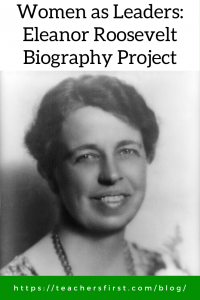“I have spent many years of my life in opposition, and I rather like the role.”
Eleanor Roosevelt
In his March 2021 newsletter, Vivek Gambhir shared eight crucial lessons we can learn from successful women leaders. Although the article focuses on women’s leadership during the pandemic, the lessons learned relate to women as leaders in general.
The eight lessons learned from successful female leaders in Gambhir’s article are an ideal focal point for students to use as they write biographies. The qualities of connecting deeply, exhibiting empathy, and transforming through purpose are among many to look for when learning about leaders.
One influential female leader from America’s past is Eleanor Roosevelt. Born on October 11, 1884, she was First Lady from 1933 – 1945 and a strong advocate for human rights. After becoming bored in the role of the wife of a politician, she sought opportunities to become involved in organizations and causes meeting her interests, and that developed her self-worth.
Often students write biographies about strong leaders but don’t always focus on the character traits that brought recognition to their valuable leadership contributions. Students can better focus on their subjects and achieve more successful outcomes with appropriate resources and guidance.
To help students focus on specific traits that demonstrate their subject’s leadership capabilities in their biography research projects, consider sharing the following resources.
Planning Tools:
- Biography Timeline Template (reviewed here) – Templates provide students with a focus on the content produced. This assortment of templates focuses on using timelines to provide a structure for student projects. For example, ask students to highlight key events in leadership, such as when Eleanor Roosevelt resigned from the Daughters of the American Revolution in 1939 over their barring African American singer Marian Anderson from performing at its Constitution Hall in Washington, DC.
- Cube Creator (reviewed here) – The cube creator from Read Write Think includes a planning template for students to use before using the interactive to create a cube. Use the template as a guide for students to focus on critical events and adjust the template as needed for student projects. For example, leave in information about the date of birth and background, but then ask students to share at least three examples of Eleanor Roosevelt’s leadership, such as her role as the chairman of the Commission of Human Rights and her work for the Democratic Party.
Research Tools:
- Read Ahead (reviewed here) – This tool helps students understand complex information and focus on important content. For example, for Eleanor Roosevelt, create a ready-made presentation from the Wikipedia entry for Mrs. Roosevelt using the keyword search feature. Next, start the presentation to view highlights of keywords and information from this article. Then, use Read Ahead to highlight information leading to a deeper understanding of the content.
- Wikipedia Timeline Generator (reviewed here) – Turn any Wikipedia entry into an instant timeline. Begin typing Eleanor Roosevelt into the search bar. The timeline generator automatically creates a timeline based on dates in the Wikipedia entry. Use this timeline to identify and determine significant events that made Mrs. Roosevelt a leader.
Presentation Tools:
- Canva for Education (reviewed here) – This tool offers many templates for creating and sharing presentations. For example, do a keyword search for the term” biography” to find templates for presentations, infographic book covers, and more. Then, offer students the choice to create an infographic book cover display with events that recognize Mrs. Roosevelt’s leadership or create a more in-depth presentation that provides additional information and context to her accomplishments.
- Genially (reviewed here) – Search in the inspiration section to find templates for interactive images, horizontal infographics, video presentations, and presentations. Tip: next to the keyword search area, use the dropdown box to filter items, including those for education and free templates. One option is to use this Oscar Wilde biography template to share information about Eleanor Roosevelt’s leadership. Change the title of the “selected works” portion to “examples of leadership.” Use Genially’s features to incorporate student-created text and links to videos and articles about Mrs. Roosevelt.
- Microsoft PowerPoint Online (reviewed here) – Use PowerPoint online to create presentations, then use the presentation recorder feature to record narrations and set timings to share presentations digitally. Learn how by reading these step-by-step directions. Many students are already familiar with PowerPoint; the recorder allows students to rehearse and prepare professional-quality presentations that include links to additional information such as online resources, books, and videos. In addition, PowerPoint Online includes collaborative features that make it easy for groups of students to create biography presentations together.
- Poll Everywhere (reviewed here) – Encourage students to engage and interact with their audience during presentations using features from Poll Everywhere. Use the Chrome extension to embed Poll Everywhere’s features into Google Slide presentations or send them to participants to use on their devices via text or access to the session URL. Create and share polls, word clouds, and interactive images. For example, stop at various times during the presentation to create a word cloud for participants to describe their thoughts on one of Eleanor Roosevelt’s accomplishments, or use the multiple choice question option to ask viewers the most critical impact of her role as a human rights champion.
During your studies of influential women, guiding students toward understanding the significance of their accomplishments through focused activities that identify specific actions and their importance in context is essential.
What additional ideas do you have that provide structure and support when writing biographies or learning about influential women? We would love to hear from you in the comments below!


